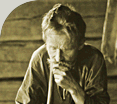|
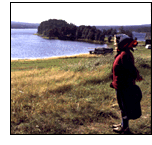 The
village of Venehjärvi is undoubtedly one of the most beautiful
in all of Viena. It is the province of the Lesonen family, for with
few exceptions every inhabitant of the village is a Lesonen and
every Lesonen in Viena can trace his or her roots back to the village.
It is commonplace in Viena that one or several families dominate
a given village. Latvajärvi, for example, "belonged to"
the Perttunen and Karhunen families. The principal families in Vuonninen
were the Malinens, the Bogdanovs and the Kieleväinens. The
old families in Vuokkiniemi were the Lipkins and the Remsus, or
Remsujevs. Kostomuksha, for its part, was the province of the Peksujevs,
the Vatanens and the Rugojevs. The
village of Venehjärvi is undoubtedly one of the most beautiful
in all of Viena. It is the province of the Lesonen family, for with
few exceptions every inhabitant of the village is a Lesonen and
every Lesonen in Viena can trace his or her roots back to the village.
It is commonplace in Viena that one or several families dominate
a given village. Latvajärvi, for example, "belonged to"
the Perttunen and Karhunen families. The principal families in Vuonninen
were the Malinens, the Bogdanovs and the Kieleväinens. The
old families in Vuokkiniemi were the Lipkins and the Remsus, or
Remsujevs. Kostomuksha, for its part, was the province of the Peksujevs,
the Vatanens and the Rugojevs.
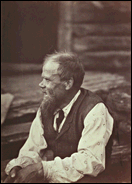  Venehjärvi
does not lie along any of the trade routes running from Viena to
Finland and was overlooked by the earliest poetry collectors. It
was thus only the later visitors who recorded what the bards of
the village had to offer. Venehjärvi
does not lie along any of the trade routes running from Viena to
Finland and was overlooked by the earliest poetry collectors. It
was thus only the later visitors who recorded what the bards of
the village had to offer.
The only collections from Venehjärvi in the first half of
the 1800s were those of J.F. Cajan, who made his work available
to Lönnrot when the latter was working on the second edition
of the Kalevala. The area was covered more thoroughly by the collectors
who followed Cajan, such as Borenius, Berner and Genetz, although
they were by no means the last to work there.
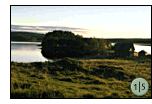 As
most of the poetry collected in Venehjärvi was collected after
the 1870s, quite a bit of personal data on the bards is available.
Among the bards interviewed by Berner, Borenius, Meriläinen
and Karjalainen were Hoto (Sokie-Hoto), Iknatta, Loasari, Oksentei,
Ontippa, Onuhrie, Hökkä-Petri and Vihtoora, all of whom
were Lesonens. Of these, Iknatta, Ontippa Onuhrie and Hökkä-Petri
were famous shamans. As
most of the poetry collected in Venehjärvi was collected after
the 1870s, quite a bit of personal data on the bards is available.
Among the bards interviewed by Berner, Borenius, Meriläinen
and Karjalainen were Hoto (Sokie-Hoto), Iknatta, Loasari, Oksentei,
Ontippa, Onuhrie, Hökkä-Petri and Vihtoora, all of whom
were Lesonens. Of these, Iknatta, Ontippa Onuhrie and Hökkä-Petri
were famous shamans.
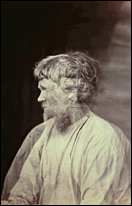  The
folk poetry records tell that the men of Venehjärvi were among
the best at bear-tales. This claim is lent much credence by the
fact that Venehjärvi has had the largest bear populations in
Karelia. In fact, the woods lying between Venehjärvi, Latvajärvi
and Lapukka are some of the most inaccessible wilderness in the
Viena cultural area. The
folk poetry records tell that the men of Venehjärvi were among
the best at bear-tales. This claim is lent much credence by the
fact that Venehjärvi has had the largest bear populations in
Karelia. In fact, the woods lying between Venehjärvi, Latvajärvi
and Lapukka are some of the most inaccessible wilderness in the
Viena cultural area.
According to tradition, the first inhabitant of Venehjärvi,
Hosko, came to the village from Finland through this wilderness
in a flat-bottomed boat carved from a single tree. He simply stopped
in the most beautiful place he found, and that was how Venehjärvi
came into being.
The history of habitation in Venehjärvi goes back to the late
1500s and early 1600s. It would be easy to determine how old the
village is through archeological studies, for every generation to
live there has been buried in Kalmisniemi, a point of land jutting
out into Lake Venehjärvi and dominating the village landscape.
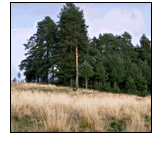 A
second essential feature of the village landscape is the pine-shaded
tšasouna (Orthodox chapel) that stands high on a hill
overlooking Kalmisniemi Point. The chapel is dedicated to the famous
Saint Miikkula, and the stand of pine there is the site of the Pohrottša
Day sacrificial ceremony held every autumn. A
second essential feature of the village landscape is the pine-shaded
tšasouna (Orthodox chapel) that stands high on a hill
overlooking Kalmisniemi Point. The chapel is dedicated to the famous
Saint Miikkula, and the stand of pine there is the site of the Pohrottša
Day sacrificial ceremony held every autumn.
These festivities are Venehjärvi's unique contribution to
culture in the Viena region. They can be seen as essentially the
equivalent of visiting a monastery. Such visits were a custom in
Uhtua, for example, where anyone who had been saved or cured after
praying to God in their hour of need or illness would bring a calf
or colt to the Solovetsky Monastery.
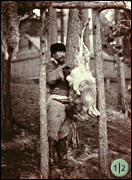  Since
the Monastery was a long way from the villages of Vuokkiniemi, the
people in that region developed an equivalent custom of their own.
The calf and colt were replaced by a ram, and the sacrificial site
was Venehjärvi. Another advantage to having the ceremony in
Venehjärvi was that the villagers themselves could eat the
meat of the animal sacrificed, which otherwise would have only contributed
to the less needy monastery. Pohrottša Day also provided an
occasion for young people to gather. Traditionally, every village
had its own holiday, or praznika, which Since
the Monastery was a long way from the villages of Vuokkiniemi, the
people in that region developed an equivalent custom of their own.
The calf and colt were replaced by a ram, and the sacrificial site
was Venehjärvi. Another advantage to having the ceremony in
Venehjärvi was that the villagers themselves could eat the
meat of the animal sacrificed, which otherwise would have only contributed
to the less needy monastery. Pohrottša Day also provided an
occasion for young people to gather. Traditionally, every village
had its own holiday, or praznika, which 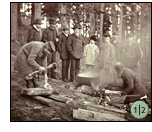 was
attended by people from surrounding villages as well. In Akonlahti,
the praznika was on St. Peter's Day, 12 July; in Kontokki
it was St. Ilja's, 2 August. Kostomuksha celebrated on Stroitsa,
or Pentecost, and Vuokinsalmi on Spring Miikkula. In Vuokkiniemi
the holiday also on St Ilja's Day. Latvajärvi celebrated Marja-Makovei,
while the traditional praznika in Uhtua was St. Peter's. was
attended by people from surrounding villages as well. In Akonlahti,
the praznika was on St. Peter's Day, 12 July; in Kontokki
it was St. Ilja's, 2 August. Kostomuksha celebrated on Stroitsa,
or Pentecost, and Vuokinsalmi on Spring Miikkula. In Vuokkiniemi
the holiday also on St Ilja's Day. Latvajärvi celebrated Marja-Makovei,
while the traditional praznika in Uhtua was St. Peter's.
|
